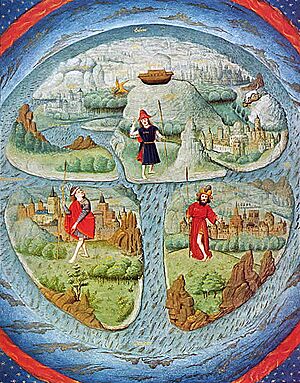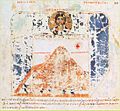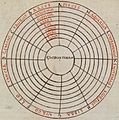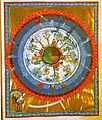Flat Earth facts for kids
The idea of a flat Earth means believing that our planet's surface is flat, like a pancake or a disk. This belief was common in very old writings and maps. For example, early maps from Mesopotamia showed the world as a flat disk floating in the ocean.
However, this idea started to change around the 4th century BC, when the Ancient Greeks began to wonder about the Earth's true shape. A smart Greek named Eratosthenes (who lived from 276 BC to 194 BC) even figured out the Earth's circumference (the distance around it) quite accurately! By then, most educated people no longer thought the Earth was flat. The idea that the Earth was round first appeared around the 6th century BC, and Aristotle later provided proof that it was a sphere around 330 BC.
The shape of the Earth really only matters when you are thinking about very long distances. So, in ancient times, mostly sailors, astronomers, and thinkers cared about whether the Earth was flat or round.
Contents
How We Learned the Earth is Round
Many important people throughout history believed the Earth was a sphere, or a ball shape. These included King Alfred, Hildegard of Bingen, Thomas Aquinas, Marco Polo, and Christopher Columbus.
Proof from Exploration
The biggest proof came from brave explorers. Portuguese sailors explored the coasts of Africa and Asia. Then, Christopher Columbus sailed to the Americas in 1492. The most convincing proof was when Ferdinand Magellan's crew sailed all the way around the Earth between 1519 and 1521. These voyages showed, in a very practical way, that the Earth is indeed a globe.
Flat Earth in Modern Times
During the 1800s, some ideas about the "Dark Ages" in Europe made the flat Earth idea seem more important than it actually was in history. People sometimes wrongly thought that everyone in the Middle Ages believed the Earth was flat.
The Flammarion Woodcut
You might have seen a famous picture called the Flammarion woodcut. It shows a man poking his head through the sky of a flat Earth to see the gears of the universe. This picture looks old, like it's from the 1500s, but it actually first appeared in a book by Camille Flammarion in 1888. The picture was meant to show a story about a medieval missionary who supposedly found where the sky and Earth met. However, this story can be traced back to a writer named Voltaire, not to any real source from the Middle Ages.
Flat Earth in Stories
The idea of a flat Earth has also appeared in books and plays. For example, in Ludvig Holberg's play Erasmus Montanus (1723), people disagree with the main character when he says the Earth is round. They all believe it's flat. He can't marry his fiancée until he says, "The Earth is flat as a pancake."
In Rudyard Kipling's story The Village that Voted the Earth was Flat, the characters spread a rumor that a local council meeting had voted that the Earth was flat.
Flat Earth in Fantasy Worlds
Fantasy stories sometimes imagine a flat Earth. In C. S. Lewis's book The Voyage of the Dawn Treader, the world of Narnia is "round like a table" (meaning flat), not "round like a ball." The characters in the story sail towards the very edge of this flat world.
Terry Pratchett's Discworld novels are set on a flat, disc-shaped world. This world rests on the backs of four giant elephants, which are standing on the back of an enormous turtle!
Related pages
Images for kids
-
Imago Mundi Babylonian map, the oldest known world map, from the 6th century BC.
-
The semi-circular shadow of Earth on the Moon during a partial lunar eclipse. This shows the Earth is round.
-
Cosmas Indicopleustes' view of the world – a flat Earth inside a Tabernacle.
-
A 12th-century T and O map showing the known world, as described by Isidore of Seville.
-
A 12th-century picture of a spherical Earth with the four seasons, from a book by Hildegard of Bingen.
See also
 In Spanish: Terraplanismo para niños
In Spanish: Terraplanismo para niños















